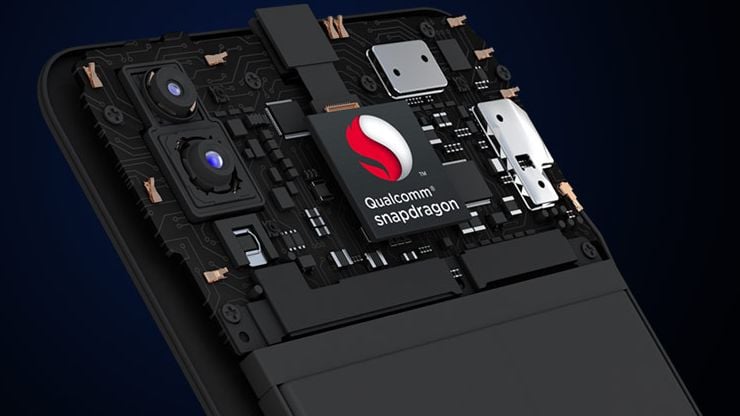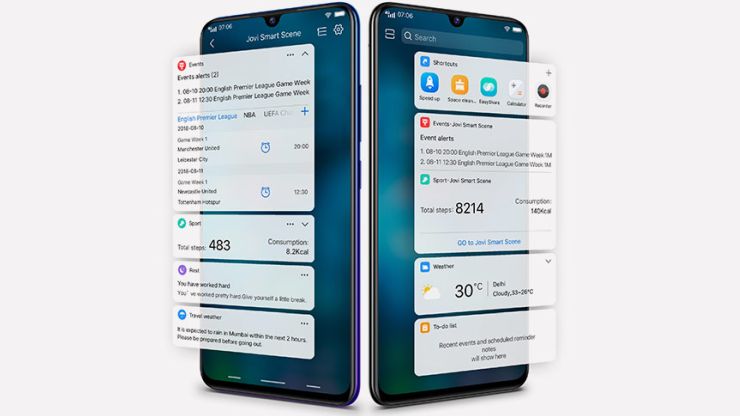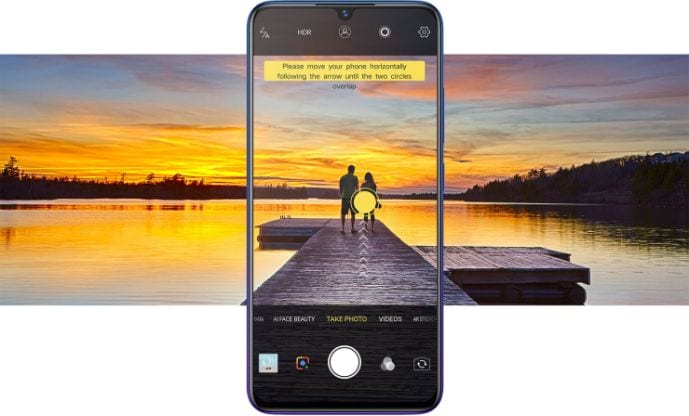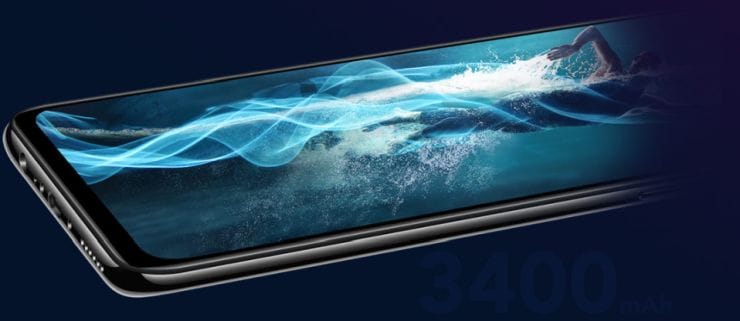In the world of selfie-centric phones, Vivo and Oppo are some of the leading and popular smartphone manufacturers. Oppo’s F series and Vivo’s V series have seen a continuous refresh over the past few years. The Vivo V11 Pro is the latest offering and also the first phone within the V series to sport the in-display fingerprint sensor, something premium manufacturers still haven’t gotten to doing. The other highlighting features of the Vivo V11 Pro are the gradient back designs and the massive 25MP selfie camera.
Priced at Rs. 25,990*, the Vivo V11 Pro is an updated version of the Vivo V9 that was launched six months ago. We have our hands on the Vivo V11 Pro and we put the phone through its paces to know what’s good and bad. Here is the detailed review.
Design and Build

The Vivo V11 Pro is a big phone with a nearly bezel-less display and beautiful gradient back. Like the recently launched Oppo F9 Pro, the V11 Pro too has a trendy waterdrop display. The phone is slim and lightweight at just 159g.
Just above the notch, is a thin earpiece cleverly placed and is hardly visible. The front camera of the Vivo V11 Pro is fitted at the center of the notch. The Vivo V11 Pro is strong and sturdy in design. The phone we tested was the Starry Night variant. It has a mix of glittery blues and purples which extends to the dark navy blue on the top. There is also a dazzling gold variant available. Unlike the F9 Pro, the sides of the Vivo V11 are not textured.

The volume controls and power button are on the right, while on the left is a dual SIM slot, also a dedicated memory card slot. The bottom of the phone has a headphone jack, a microUSB port and a mono speaker. The camera on the Vivo V11 Pro are vertically aligned with a metal gold ring stripped around. There is a LED flash below it. The Vivo logo is engraved in the center. The phone has a curvy design at the back, which makes it comfortable to hold in one hand.
Features

The Vivo V11 Pro is packed with a lot of interesting features. It has a large 6.4-inch AMOLED screen, which Vivo calls Halo FullView display. The screen sports a full HD+ resolution of 2340 x 1018, which makes the screen look bright and colourful. Also, the viewing angles are really great. The highlighted feature of the Vivo V11 Pro is its fingerprint sensor hidden within the display, giving the phone a futuristic look.

The Vivo V11 Pro is packed with a Qualcomm Snapdragon 660 octa-core processor. It is a mid-range processor and should offer good performance. The 6GB of RAM should add an additional performance boost to the processor. The phone comes with 64GB of internal storage which can be expanded up to 256GB using a microSD card. This is enough storage to store loads of music, photos, videos and movies. The phone is backed with a 3,400 mAh battery that should last a day on average usage. Vivo claims that the Vivo V11 Pro is equipped with dual-engine Fast charging feature, which helps charge the phone even faster.

In addition to the dual rear cameras, rated at 12MP and 5MP, the Vivo V11 Pro also comes with a 25MP front camera placed in the center of the tiny notch. Both the cameras should be great for photography enthusiasts. Vivo has provided the required modes and image processing settings within the Camera app. In terms of connectivity, the phone supports dual SIM cards with VoLTE support. Besides this, there are the latest standards of Bluetooth (5.0) and WiFi (802.11ac) built into the device. There is no NFC support.
The Vivo V11 Pro runs on FunTouch OS 4.5, that overlays Android 8.1. The interface is easy to use, but there is no app drawer. All the apps appear on the home screen when you install them.
Performance

The overall performance of the Vivo V11 Pro was good. We spent a lot of time playing games, browsing, clicking photos, shooting videos and playing videos; not once did the Vivo V11 Pro lag or slow down. The AMOLED screen looks great, bright and colourful. The interface is smooth and accurate. Quick settings menu is accessible on swiping the screen from bottom to top. This gesture is common on Vivo phones and is handy since the screen is so large. There are a lot of other smart features such as the Jovi AI assistant, apps clone, as well as themes and wallpapers for customizing your phone. The phone was able most heavy tasks effectively. There wasn’t any heating even with a good amount of playing PUBG and Asphalt Street Storm. Both the games ran satisfactorily and were manageable on medium to high settings.

We ran some benchmarks as well to gauge the performance of the phone. The 3DMark Sling Shot Extreme gaming benchmark earned an OpenGL score of 1,205, whereas the Vulkan score was 958. The score is much better than its nearly priced, the Oppo F9 Pro. The AnTuTu benchmark that runs several tests for CPU, GPU and memory on the phone scored 1,24,334. This is a really good score in a phone in this price range. The Geekbench benchmark’s single-core and multi-core scores were lower than the Oppo F9 Pro. We got a score of 1,439 and 5,498 respectively.

The highlighted feature of the Vivo V11 Pro is its in-display fingerprint sensor that is used to unlock the phone. The lower area on the screen automatically displays the fingerprint logo when any motion is detected. This means you know where exactly you have to place the finger. When trying to unlock the phone, we had to accurately place the finger and also apply a little bit of pressure. It wasn’t as quick as a dedicated, physical fingerprint. Comparatively, face authentication worked faster. Another highlighted feature of the Vivo V11 Pro is the 25MP selfie camera. There are a lot of camera modes, filters, AR stickers and settings to play with. The selfie camera has an option to compensate brightness for perfect photos, selfie lighting that gives effects as Bokeh mode and many more. The front camera allows to click HD and full HD videos with a video face beauty mode. Selfies look really good although, it smoothens the skin tone quite a bit, which can make the photo look artificial. Photos have good details, but the colours look over-saturated.

Coming to the rear camera, you get the same camera modes as the front camera. There is an addition of normal, slow motion and time-lapse modes. We clicked a decent number of photos and each one showed good colours and details. The contrast and sharpness levels in close-up, macro photos are impressive. The camera on the Vivo V11 Pro can be comparable to some high-end phones, in some aspects. The rear camera can shoot videos up to 4K, but the difference between full HD and 4K videos is barely noticeable. Although, the colours in full HD videos appeared a tad bit more natural than the 4K videos. We were able to run all these tasks on a 3,400 mAh battery packed in the Vivo V11 Pro. Standard power saving features such as “Low Power Mode” as present. It reduces the CPU performance, reduces the brightness and disables wireless connectivity options to conserve battery. To charge the phone, there is 18W charger bundled along with the phone, similar to other quick chargers. We were able to charge the V11 Pro to about 21 per cent in about 15 minutes.

The Vivo V11 Pro comes with a mono speaker. We played music on full volume and the speaker delivers good sound. It has good bass, clarity and the vocals sound clear. The sound quality is really good if you have to play music or want to watch a movie.
Verdict
The Vivo V11 Pro has everything you would want in an upper mid-range phone. There are lots of smart features that make using the Vivo V11 Pro fun. The phone has an AMOLED waterdrop display, which is an upcoming trend, also an all-new in-display fingerprint, a good 3400 mAh battery, an impressive 25MP selfie camera with addition to the dual cameras at the back. There are some aspects that could have made the Vivo V11 Pro even better. The in-display fingerprint needs to be more refined, and Vivo could have included a Type-C USB port. All things considered, there are no phones in this price range, to offer in-display fingerprint to date. If you are looking for a cheaper alternative to the device, the Oppo F9 Pro is an option with near-identical specifications, but you need to skip out on the in-display fingerprint sensor.




